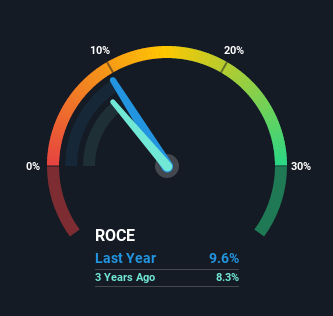- India
- /
- Consumer Durables
- /
- NSEI:AMBER
Investors Could Be Concerned With Amber Enterprises India's (NSE:AMBER) Returns On Capital

Finding a business that has the potential to grow substantially is not easy, but it is possible if we look at a few key financial metrics. Amongst other things, we'll want to see two things; firstly, a growing return on capital employed (ROCE) and secondly, an expansion in the company's amount of capital employed. Put simply, these types of businesses are compounding machines, meaning they are continually reinvesting their earnings at ever-higher rates of return. However, after briefly looking over the numbers, we don't think Amber Enterprises India (NSE:AMBER) has the makings of a multi-bagger going forward, but let's have a look at why that may be.
Return On Capital Employed (ROCE): What is it?
For those who don't know, ROCE is a measure of a company's yearly pre-tax profit (its return), relative to the capital employed in the business. Analysts use this formula to calculate it for Amber Enterprises India:
Return on Capital Employed = Earnings Before Interest and Tax (EBIT) ÷ (Total Assets - Current Liabilities)
0.096 = ₹2.0b ÷ (₹30b - ₹9.2b) (Based on the trailing twelve months to December 2021).
Therefore, Amber Enterprises India has an ROCE of 9.6%. Ultimately, that's a low return and it under-performs the Consumer Durables industry average of 14%.
Check out our latest analysis for Amber Enterprises India

Above you can see how the current ROCE for Amber Enterprises India compares to its prior returns on capital, but there's only so much you can tell from the past. If you'd like, you can check out the forecasts from the analysts covering Amber Enterprises India here for free.
What Does the ROCE Trend For Amber Enterprises India Tell Us?
On the surface, the trend of ROCE at Amber Enterprises India doesn't inspire confidence. Around five years ago the returns on capital were 16%, but since then they've fallen to 9.6%. Although, given both revenue and the amount of assets employed in the business have increased, it could suggest the company is investing in growth, and the extra capital has led to a short-term reduction in ROCE. And if the increased capital generates additional returns, the business, and thus shareholders, will benefit in the long run.
On a related note, Amber Enterprises India has decreased its current liabilities to 31% of total assets. So we could link some of this to the decrease in ROCE. Effectively this means their suppliers or short-term creditors are funding less of the business, which reduces some elements of risk. Some would claim this reduces the business' efficiency at generating ROCE since it is now funding more of the operations with its own money.
The Bottom Line On Amber Enterprises India's ROCE
Even though returns on capital have fallen in the short term, we find it promising that revenue and capital employed have both increased for Amber Enterprises India. And long term investors must be optimistic going forward because the stock has returned a huge 386% to shareholders in the last three years. So while the underlying trends could already be accounted for by investors, we still think this stock is worth looking into further.
Like most companies, Amber Enterprises India does come with some risks, and we've found 1 warning sign that you should be aware of.
If you want to search for solid companies with great earnings, check out this free list of companies with good balance sheets and impressive returns on equity.
New: Manage All Your Stock Portfolios in One Place
We've created the ultimate portfolio companion for stock investors, and it's free.
• Connect an unlimited number of Portfolios and see your total in one currency
• Be alerted to new Warning Signs or Risks via email or mobile
• Track the Fair Value of your stocks
Have feedback on this article? Concerned about the content? Get in touch with us directly. Alternatively, email editorial-team (at) simplywallst.com.
This article by Simply Wall St is general in nature. We provide commentary based on historical data and analyst forecasts only using an unbiased methodology and our articles are not intended to be financial advice. It does not constitute a recommendation to buy or sell any stock, and does not take account of your objectives, or your financial situation. We aim to bring you long-term focused analysis driven by fundamental data. Note that our analysis may not factor in the latest price-sensitive company announcements or qualitative material. Simply Wall St has no position in any stocks mentioned.
About NSEI:AMBER
Amber Enterprises India
Provides room air conditioner solutions in India.
Solid track record with reasonable growth potential.


